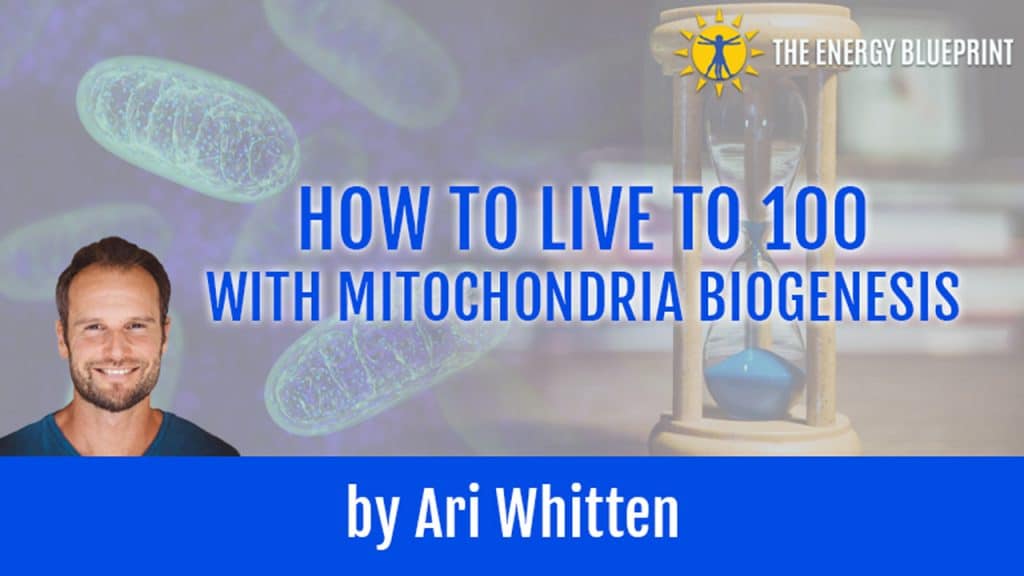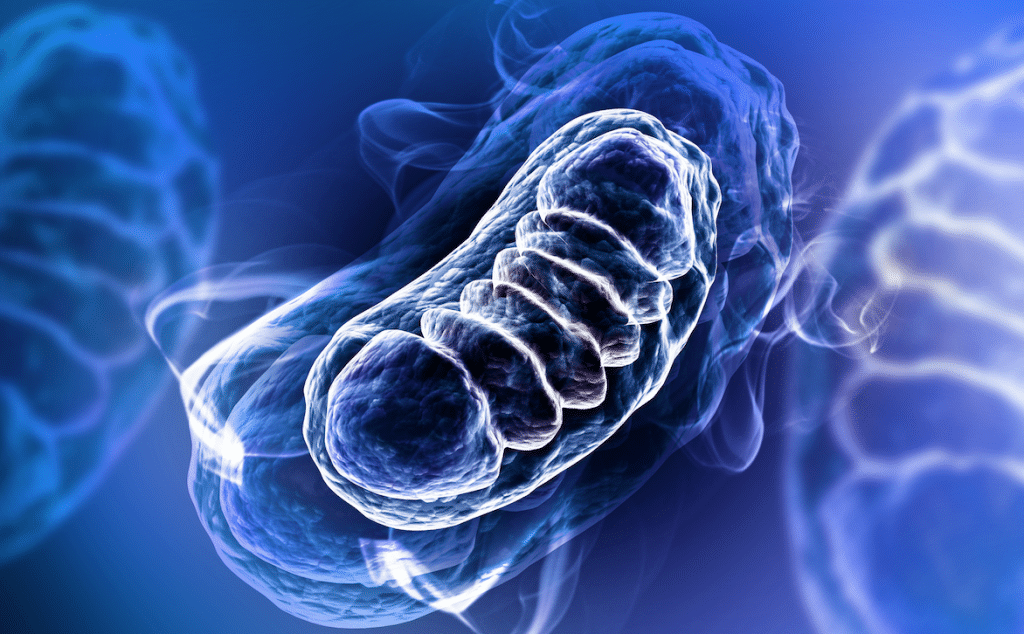
show
What is Mitochondrial Biogenesis?
Mitochondrial biogenesis is simply the process by which your body makes more mitochondria.
This usually occurs as a result of an increased demand for energy. 1 The result of mitochondrial biogenesis is an increase in the number and size of mitochondria within a cell, which means an increased capacity to produce energy or ATP. 2 Mitochondrial biogenesis is influenced by environmental stress such as exercise, caloric restriction, nutrient cycling, cold exposure, heat exposure, temporary oxygen deprivation, UV light, certain phytonutrients, and xenobiotics as well as red and near-infrared light.
Mitochondrial biogenesis was first described over 40 years ago by a pioneer in the field of exercise physiology named John Holloszy, a professor at Washington University in St. Louis, MO. He found that endurance training resulted in large increases in muscle mitochondrial content, which increased the ability of a muscle to take up glucose during and after exercise. 3
What is mtDNA?
Mitochondria have their own DNA, mitochondrial DNA (mtDNA), which are small circular chromosomes found inside the mitochondria. Mitochondrial DNA contains 37 genes, all of which are essential for normal mitochondrial function.
Thirteen of these genes provide instructions for making enzymes involved in oxidative phosphorylation and the rest provide instructions for making molecules called transfer RNA (tRNA) and ribosomal RNA (rRNA), which are chemical cousins of DNA. They help assemble protein building blocks (amino acids) into functioning proteins. 4
Interestingly, mtDNA are passed on to offspring through the mother’s egg and not the father’s sperm, which allows us to trace ancestry down the female line. It also makes mtDNA of particular interest in forensics, to identify people or corpses. 5
Understanding How Mitochondrial Biogenesis Works
Mitochondria are produced from the transfer of information from genes both in the nuclear genome and in the mitochondrial genome. 6 Mitochondrial biogenesis requires careful coordination of nuclear and mitochondrial genes to ensure the correct assembly and function of a large set of proteins that comprise the mitochondrial respiratory chain. The shape of Mitochondria is largely determined by a balance between fission and fusion activities of mitochondria. 7
Fission is the division of a single organelle into two or more independent structures. It is a complex process that involves the separation of both the OMM (outer mitochondrial membrane) and IMM (inner mitochondrial membrane) and then their rejoining in the correct orientation. The process requires the proper separation of mitochondrial proteins and mtDNA (mitochondrial DNA) so that each daughter organelle can function normally. 8
Mitochondrial fusion, on the other hand, is the physical merging of the outer and then the inner mitochondrial membranes of two originally distinct mitochondria. 9 Fusion helps mitigate stress by mixing the contents of partially damaged mitochondria to create new healthier mitochondria.
Metabolic homeostasis results from coordination and close cooperation of mitochondrial biogenesis and mitophagy (the removal of damaged mitochondria through autophagy). Both processes must occur in balance to ensure the removal of damaged and/or superfluous mitochondria and the creation of new healthy mitochondria. 10
Disequilibrium between mitochondrial biogenesis and selective autophagy causes deterioration of cellular function and cell death, which may result in several pathological conditions in humans, including neurodegenerative diseases, myopathies, and other age-associated disorders.
Regulation of Mitochondrial Biogenesis
Mitochondrial biogenesis is mainly mediated by the activation of peroxisome proliferator-activated receptor-gamma coactivator 1 alpha (PGC1α). 11 PGC1α, is a transcriptional coactivator and the master regulator of mitochondrial biogenesis. It also plays a critical role in the maintenance of glucose, lipid, and energy homeostasis. PGC1α is highly responsive to a variety of environmental cues, from temperature to nutritional status to physical activity, and is itself activated by elevated AMP and NAD+ levels.
When activated, PGC1α triggers the release of several transcription factors, including nuclear respiratory factors (Nrf1 and Nrf2) and peroxisome proliferator-activated receptors (PPARs), which protect the mitochondria from oxidative damage and regulate metabolic pathways and biological processes in a tissue-specific manner.
How Thyroid Hormone Promotes Mitochondrial Biogenesis
Thyroid hormone (T3) has a profound influence on normal development and metabolism. 12 Hypothyroidism is associated with a considerable decrease in basal metabolic rate, oxygen consumption and rate of oxidation of glucose, fatty acids, and amino acids. Injection with T3, to raise thyroid hormone levels, by contrast, increases oxygen consumption, metabolic rate, body temperature, and heart rate, within 24-48 hours. 13
Thyroid hormone (T3) has a profound effect on mitochondrial biogenesis and cellular oxidative capacity, possibly through activation of Nrf1 and PGC1α. 14 15 It activates the uncoupling of oxidative phosphorylation through various mechanisms involving inner membrane proteins and lipids, which appears to be responsible for some of the hyper-metabolic effects of thyroid hormone. 16
Excess thyroid hormone, such as in hyperthyroidism, has been associated with an increased production in reactive oxygen species (ROS) resulting in tissue oxidative injury, which can lead to mitochondrial damage and respiratory impairment. 17 So while having an excess amount of thyroid hormone isn’t a good thing for the health of the mitochondria, having healthy levels of thyroid hormone can help to protect the mitochondria from damage.
Supporting healthier thyroid function is an important part of enhancing both overall mitochondrial performance and biogenesis. If you think you suffer from an underactive thyroid, see your physician and get yourself tested.
Anti-Aging Benefits of Mitochondrial Biogenesis

A decline in mitochondrial quality and activity has been associated with normal aging and correlates with the development of a wide range of age-related diseases. Mitochondria contribute to particular aspects of the aging process including cellular senescence, chronic inflammation and the age-dependent decline in stem cell activity. 18
Mitochondrial dysfunction affects many conditions including cardiovascular disease, neurodegenerative diseases, such as Alzheimer’s, Parkinson’s and Huntington’s disease, depression, ADHD, Chronic Fatigue, ME and Fibromyalgia, Type 2 diabetes as well as others typically associated with aging, like hearing and vision loss.
Age-related hearing loss affects approximately one-third of all people over the age of 65 and is due to changes that occur in the aging body. In his book, Save Your Hearing Now, Michael Seidman shows that hearing loss is due to free-radical damage and mitochondrial dysfunction and can be reversed through optimizations of nutritional and lifestyle choices, especially those that encourage mitochondrial biogenesis, such as calorie restriction.
Similarly, raising NAD+ levels in older mice appears to restore mitochondrial function. 19 Increases in NAD+ levels activate PGC1α, which triggers mitochondrial biogenesis. As such, there is considerable enthusiasm to develop methods to increase NAD+ levels, either through direct supplementation or by altering NAD+ metabolism. 20
Impaired mitochondrial energy production also plays an important role in aging of the skin. Fibroblast cells, which produce collagen and elastin and keep skin looking youthful, demonstrate dramatic mitochondrial dysfunction. The resulting drop in energy makes these cells less capable of carrying out essential skin-related functions, which contribute to the wrinkling, dryness, sagging, dullness and poor healing of aged skin. 21 22
In addition, age-related macular degeneration, cataract, and glaucoma also show mitochondrial components to them.
Mitochondrial biogenesis slows down aging, by increasing the capacity for energy production. Improvements in energy production, in turn, can have far-reaching benefits from increased longevity to improved energy utilization and protection from free radicals. For healthier aging, we need our cells to selectively get rid of defective mitochondria (through mitophagy) and replace them, through mitochondrial biogenesis, with new higher-performing ones.
How to Activate Mitochondrial Biogenesis
When mitochondria dysfunction, everything has the potential to dysfunction, so stimulating mitochondrial biogenesis is the key to maintaining health, energy, and longevity. 23 24 The more mitochondria you have the greater your capacity to adapt and deal with stressors. As stressors are ubiquitous in the modern world and very hard to avoid, having bigger, better and more mitochondria is advantageous.
Lack of mitochondrial stimulation is the raison d’être for poor mitochondrial function/dysfunction. Conversely stimulating your mitochondria can add years to life, prevent disease, improve resilience and dramatically improve energy levels. The key to this is hormesis.
Hormesis is ‘a process in which exposure to a low dose of a chemical agent or environmental factor that is damaging at higher doses induces an adaptive beneficial effect on the cell or organism’. 25 Exercise is one example of a hormetic stressor. Others include fasting, UV light exposure, heat and cold exposure, xenohormetins (certain phytochemical found in food) and xenobiotics, etc. These work by producing a temporary stress that triggers the body’s cell danger response (CDR), which then stimulates adaptations that build resilience and resistance to other stressors. 26
For example, heat exposure through sauna use has a direct association with all-cause mortality. Numerous studies have shown that as frequency and duration of sauna use increases the risk of dying decreases. If any drug could have the same effect, it would be hailed as a panacea. Sauna therapy is powerful medicine and its benefits are backed by science. 27
In one study on patients suffering from chronic fatigue syndrome, symptoms such as fatigue, pain, and sleep were dramatically improved after 15 to 25 sessions of thermal therapy. 28
Intermittent Hypoxia is another often underutilized form of hormesis. Intermittent hypoxic training (IHT) uses breathing techniques (such as pranayama) to induce low oxygen levels in the blood (and therefore in the cells and mitochondria as well) to progressively train mitochondria to use oxygen more efficiently.
Beneficial changes in the mitochondria include :
- Mitochondrial biogenesis
- Decreased inflammation
- Increased exercise performance
- Increased nervous system balance
- Better sleep
- Increased resistance to stress
- Better immune function
- Increased energy
Intermittent hypoxia literally remodels the interface between the air sacs (alveoli) in the lungs and the blood by changing the structure of mitochondria.
One study of 102 human patients concluded that IHT may be a bona fide anti-aging treatment because it helps clean out damaged and dysfunctional mitochondria and replaces them with healthy mitochondria (among other anti-aging mechanisms, including stimulation of stem cells). Another study showed remarkable beneficial effects of IHT in the treatment of cardiovascular disorders such as hypertension, coronary artery disease, and heart failure. 29
Our ancestors lived in a time when hormesis was built into their lives. Today, we no longer need to exercise, never face food scarcity, eat an unhealthy diet devoid of dietary phytonutrients and live in an insulated, climate-controlled environment, never feeling either too hot or too cold. This is the age of anti-hormesis, which results in fragility. Too little stress is as toxic as too much stress and regular exposure to hormetic stress is critical for optimal health and longevity. 30 31 32 33 34
Summary
Mitochondrial biogenesis has been shown to decrease with age but only if you do not expose yourself to regular hormetic stressors. In may not be a stretch to say that hormesis, which stimulates mitochondrial biogenesis and mitophagy, maybe the fountain of youth. By increasing resilience, resistance to stress and disease, decreasing inflammation and boosting energy, it induces an organism’s adaptive response and ultimately results in lifespan-extension and health promotion. 35 PGC-1α plays a central role and is a major regulator of this process.
When it comes to hormesis, however, as Paracelsus, the famous medieval alchemist said hundreds of years ago, “It’s the dose that makes the poison,” so it is extremely important to find the correct dose for the desired effect. As with most things, too much can be detrimental and too little is ineffective.
References[+]
| ↑1 | Jornayvaz, François R, and Gerald I Shulman. “Regulation of mitochondrial biogenesis.” Essays in biochemistry vol. 47 (2010): 69-84. doi:10.1042/bse0470069 |
|---|---|
| ↑2 | Hood, D. A. “Mechanisms of exercise-induced mitochondrial biogenesis in skeletal muscle.” Appl. Physiol. Nutr. Metab. Physiol. Appliquée Nutr. Métabolisme 34, 465–472 (2009) |
| ↑3 | Holloszy, J. O. “Biochemical adaptations in muscle. Effects of exercise on mitochondrial oxygen uptake and respiratory enzyme activity in skeletal muscle.” J. Biol. Chem. 242, 2278–2282 (1967) |
| ↑4 | https://ghr.nlm.nih.gov/mitochondrial-dna |
| ↑5 | Lee, K. “Mitochondria and the Future of Medicine: the key to understanding disease, chronic illness, aging and life itself.” (2018) |
| ↑6 | https://en.wikipedia.org/wiki/Mitochondrial_biogenesis |
| ↑7 | Osellame, Laura D et al. “Cellular and molecular mechanisms of mitochondrial function.” Best practice & research. Clinical endocrinology & metabolism vol. 26,6 (2012): 711-23. doi:10.1016/j.beem.2012.05.003 |
| ↑8 | Scott, Iain, and Richard J Youle. “Mitochondrial fission and fusion.” Essays in biochemistry vol. 47 (2010): 85-98. doi:10.1042/bse0470085 |
| ↑9 | Mishra, Prashant, and David C Chan. “Metabolic regulation of mitochondrial dynamics.” The Journal of cell biology vol. 212,4 (2016): 379-87. doi:10.1083/jcb.201511036 |
| ↑10 | Palikaras, K et al. “Balancing mitochondrial biogenesis and mitophagy to maintain energy metabolism homeostasis.” Cell death and differentiation vol. 22,9 (2015): 1399-401. doi:10.1038/cdd.2015.86 |
| ↑11 | Pankaj, Prasun M.D. “Chapter 5 – Treatment of Mitochondrial Diseases.” Mitochondrial Medicine – A Primer for Health Care Providers and Translational Researchers 2019, Pages 15-20. https://doi.org/10.1016/B978-0-12-817006-9.00005-8 |
| ↑12 | Yen (PM) 2001. “Physiological and molecular basis of thyroid hormone action.” Physiol Review 81, 1097-1142. |
| ↑13, ↑14 | Weitzel JM, Iwen KA, Seitz HJ. “Regulation of mitochondrial biogenesis by thyroid hormone.” Exp Physiol. 2003 Jan;88(1):121-8. DOI: 10.1113/eph8802506 |
| ↑15 | Weitzel JM1, Iwen KA. “Coordination of mitochondrial biogenesis by thyroid hormone.” Mol Cell Endocrinol. 2011 Aug 6;342(1-2):1-7. doi: 10.1016/j.mce.2011.05.009. |
| ↑16 | Harper, M.E, Seifert E.L. “ Thyroid hormone effects on mitochondrial energetics.” Thyroid. 2008 Feb;18(2):145-56. doi: 10.1089/thy.2007.0250. |
| ↑17 | Venditti, P., Di Meo, S. “Thyroid hormone-induced oxidative stress.” Cell Mol Life Sci. 2006 Feb;63(4):414-34. DOI: 10.1007/s00018-005-5457-9 |
| ↑18 | Sun, Nuo et al. “The Mitochondrial Basis of Aging.” Molecular cell vol. 61,5 (2016): 654-666. doi:10.1016/j.molcel.2016.01.028 |
| ↑19 | Gomes AP, et al. “Declining NAD(+) induces a pseudohypoxic state disrupting nuclear-mitochondrial communication during aging.” Cell. 2013;155:1624–1638. |
| ↑20 | Canto C, Menzies KJ, Auwerx J. “NAD(+) Metabolism and the Control of Energy Homeostasis: A Balancing Act between Mitochondria and the Nucleus.” Cell metabolism. 2015;22:31–53 |
| ↑21 | Stout, R., Birch-Machin, M. “ Review: Mitochondria’s Role in Skin Ageing.” Dermatological Sciences, Institute of Cellular Medicine, Medical School, Newcastle University, 11 May 2019. |
| ↑22 | Bhupendra Singh, Trenton R. Schoeb, Prachi Bajpai, Andrzej Slominski, Keshav K. Singh. Reversing wrinkled skin and hair loss in mice by restoring mitochondrial function. Cell Death & Disease, 2018; 9 (7) DOI: 10.1038/s41419-018-0765-9 |
| ↑23 | Hwang, Ara B et al. “Mitochondria and organismal longevity.” Current genomics vol. 13,7 (2012): 519-32. doi:10.2174/138920212803251427 |
| ↑24 | Nunnari, Jodi, and Anu Suomalainen. “Mitochondria: in sickness and in health.” Cell vol. 148,6 (2012): 1145-59. doi:10.1016/j.cell.2012.02.035 |
| ↑25 | Mattson, Mark P. “Hormesis defined.” Ageing research reviews vol. 7,1 (2008): 1-7. doi:10.1016/j.arr.2007.08.007 |
| ↑26 | Naviaux, Robert. “Metabolic Features of the Cell Danger Response.” J. Mitochondrion, Vol 6, 2013/08/24, doi: 10.1016/j.mito.2013.08.006 |
| ↑27 | Soejima, Yuji et al. “Effects of Waon therapy on chronic fatigue syndrome: a pilot study.” Internal medicine 54 3 (2015): 333-8. |
| ↑28 | Masuda, A. et al. “The effects of repeated thermal therapy for two patients with chronic fatigue syndrome.” J Psychosom Res. 2005 Apr;58(4):383-7. |
| ↑29 | Serebrovskaya, Tatiana V, and Lei Xi. “Intermittent hypoxia training as non-pharmacologic therapy for cardiovascular diseases: Practical analysis on methods and equipment.” Experimental biology and medicine (Maywood, N.J.) vol. 241,15 (2016): 1708-23. doi:10.1177/1535370216657614 |
| ↑30 | Zimmermann, Andreas et al. “When less is more: hormesis against stress and disease.” Microbial cell (Graz, Austria) vol. 1,5 150-153. 5 May. 2014, doi:10.15698/mic2014.05.148 |
| ↑31 | Kahn, Arnold, and Anders Olsen. “Stress to the rescue: is hormesis a ‘cure’ for aging?.” Dose-response : a publication of International Hormesis Society vol. 8,1 48-52. 7 Dec. 2009, doi:10.2203/dose-response.09-031.Olsen |
| ↑32 | Newman, Tim. “Cellular stress ‘resets lifespan profoundly’” Medical News Today |
| ↑33 | Rattan, S.I. “Hormesis in aging.” Ageing Res Rev. 2008 Jan;7(1):63-78. Epub 2007 Aug 31. |
| ↑34 | Mattson, M.P. “Hormesis and disease resistance: activation of cellular stress response pathways.” Hum Exp Toxicol. 2008 Feb;27(2):155-62. doi:10.1177/0960327107083417. |
| ↑35 | Ristow M., Zarse K. How increased oxidative stress promotes longevity and metabolic health: The concept of mitochondrial hormesis (mitohormesis) Exp. Gerontol. 2010;45:410–418. |




